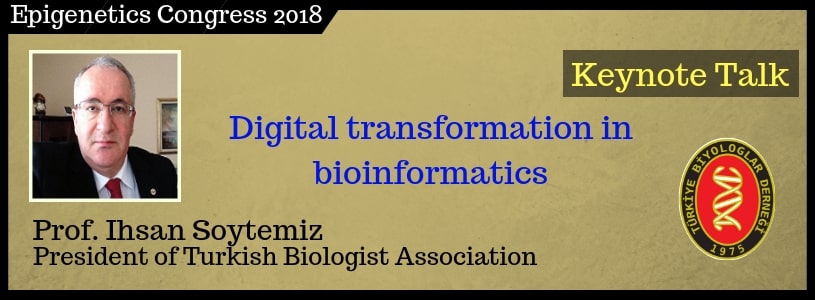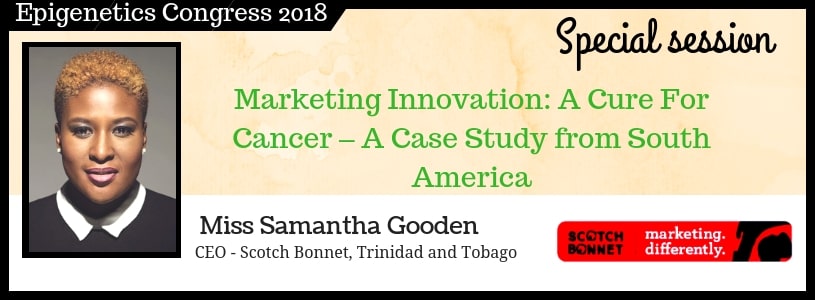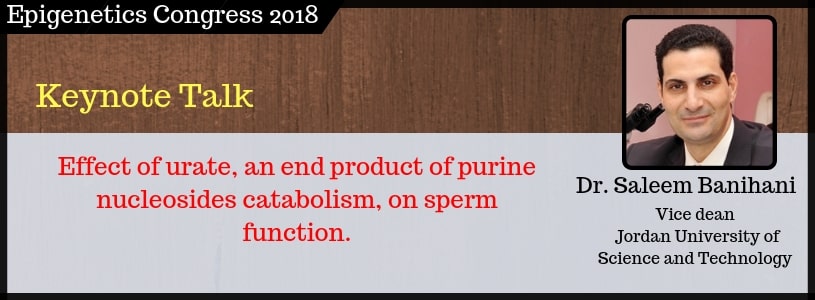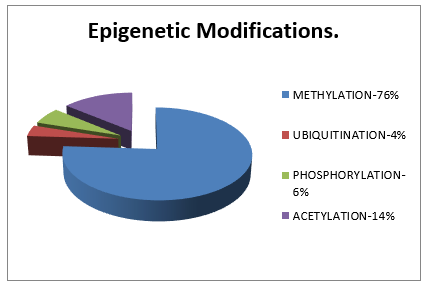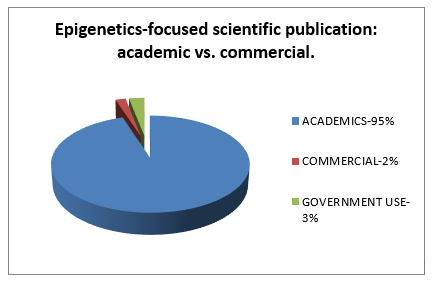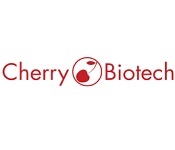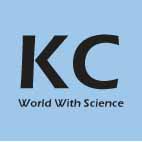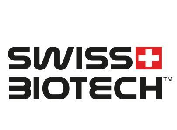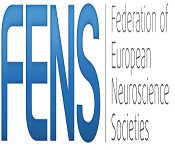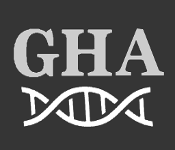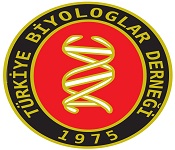Theme: Shaping the future of Epigenetics and Genome Biology
Epigenetics Congress 2018
- About Conference
- Sessions/Tracks
- Market Analysis Report
- New Updates - Epigenetics and Chromosome
- Past Conference Report
Epigenetics Conference 2018
Epigenetics Congress 2018 invites all the participants from all over the world to attend 5th World Congress on Epigenetics and chromosome during November 15-16, 2018, Istanbul, Turkey. The principal objective of this congress is to provide a platform for cutting-edge research in epigenetics and chromosome. Through energize sessions and plenty of networking, you will learn to be more brave and audacious than you are now and free to develop your mind, increase your business, and change your bottom-line in positive way.
Epigenetics defined as the study of the epigenotype, which deals with the study of the properties of the pathways and processes that link the genotype and phenotype.
Why Turkey?
Education in Turkey comes under Ministry of National education and for the increase in demand of higher education many colleges and universities are established in turkey. There are 166 universities in Turkey. Istanbul University is the oldest university founded in 1453 in Turkey. As the Research sector is widely developed in Turkey and having major Research Centres like Scientific and Technological Research Council of Turkey, Turkish academy of Sciences, Turkish Anatomic Research Authority, Defence Industries Research and Development Institute, Space Technologies Research Institute, Turkish Chemical Society, Istanbul Technical University, Middle east Technical University etc. Turkey is one of larger country in Europe. Italy is the largest economic partner of Turkey. 30% population of Turkey is employed in Agriculture. Hazel nuts, Apricots, Figs, Tea, Tobacco, and Citrus Fruits are their major Products of Agriculture.
Target Audience
The organization working in:
- Genetics
- Genomics and Proteomics
- Bioinformatics
- Molecular Biology
- Medicine
- Organic Chemistry
- Natural Science field
- Stem cell biology
- Cancer
- Oncology
- Deans & Directors of Biology Universities and Institutes
- Scientists
- Biomedical companies
- Pharmaceutical companies
- Business Entrepreneurs
- Public wellbeing experts
Track 1: Epigenetics
Epigenetics is meant by the study of heritable changes in gene function without involving the changes in DNA arrangement. It mainly involves the changes in a chromosome which affects gene activity and functions, and also be used to report any heritable phenotypic change which does not derive from a modification of the genome. Epigenetics defined as the study of the epigenotype, which deals with the study of the properties of the pathways and processes that link the genotype and phenotype. A large number of diseases in humans such as cancer, metabolic syndromes and brain disorders have been related with irregularity in epigenetic processes.
-
DNA damage
-
Covalent modification
-
Structural Inheritance
-
Nucleosome positioning
-
Transgenerational
Track 2: Epigenetic Disorders
Epigenetic modifications are the cause for the disease developments, environmental exposure, drug treatment and aging. Epigenetic changes can be reversible and are potentially targeted by pharmacological intervention. Epigenetic changes are the factors of human diseases, including Fragile X syndrome, Angelman’s syndrome, Prader-Willi syndrome, and various cancers.About 80% of brain disorders are related with multiple genomic defects in conjunction with environmental factors and epigenetic phenomena.
-
Autosomal dominant polycystic kidney disease
-
Mitochondria diseases
-
Nondisjunction
-
Aneuploidy
-
Cardiovascular diseases
Track 3: Cancer Epigenetics
Cancer epigenetics is consider as the study of actual heritable changes to molecular processes which influence the flow of information between the DNA of cancer cells and their gene expression patterns. This includes comparison between tumor cell and normal cell and investigation of nuclear organization, DNA methylation, histone modification and the consequences of genetic mutations in genes encoding epigenetic regulators. DNA methylation patterns undergo complex changes in cancer.
-
Histone modification
-
MicroRNA gene silencing
-
Epigenetic carcinogenic
-
Prostate cancer
-
Cervical cancer
Track 4: Behavioral Epigenetics
Behavioral epigenetics is referring to the study the role of epigenetics in shaping animal and human behavior. It is an observational science that explores that how the nurture shapes the biological heredity, where nurture refers to virtually all things that occur during the life-span like social-experience, diet and nutrition, and exposure to toxins. Behavioral epigenetics is giving a structure to know about how the expression of genes is altered by experiences and environment for forming the differences in behavior, cognition, personality, and mental health of everyone.
-
Drug addiction
-
Psychopathy
-
Depressive disorder
-
Eating disorder
-
Social behavior of insects
Track 5: Animal Epigenetics
Epigenetic and transgenerational epigenetic inheritance research are performed on a multiple number of mammal, insect, and plant. A lack of research into these topics using farm animal models (bovine, porcine, ovine, and gallus) exists. Research into epigenetic transgenerational inheritance is limited because much of the work has focused on the direct effects of environmental submission to toxicants and nutrients. Pesticides are the cause of having dramatic transgenerational epigenetic effects on many of the animal models which affecting the nervous system, reproductive and endocrine systems, and even causing cancer.
-
Animal epigenetics welfare
-
Animal models in epigenetics research
-
Animal epigenetics examples
-
Animal cloning epigenetics
Track 6: Plant Epigenetics
Plants are mainly depending on epigenetic processes for their proper functions. Plant epigenomes are more susceptible to environmental influence than those in animals. Epigenetic mechanisms are required for proper regulation while epi-alleles and epi-mutants, much like their genetic complements, describe changes in phenotype associated with distinct epigenetic circumstance. The study of epigenetics in plants is scientifically enthusiasm because epigenetics have long-standing importance in agriculture.
-
Growth and Development
-
Plant Transgenerational Epigenetics
-
Genotype and Phenotype
-
Epitranscriptomics
Track 7: Cytogenetics
Cytogenetics is defined as the study of chromosomal structure, chromosome location and function in cells. Modern cytogenetic approaches are enable to precisely label the chromosomal location of any gene using different colored dots, examine cells from any type of tissue (even tumor cells), identify cells that have lost or gained a specific chromosome and determine whether specific regions of chromosomes have been lost or gained without ever looking at the chromosomes under a microscope.
-
Cancer cytogenetics
-
Karyotyping
-
Fluorescent in situ hybridization
-
Cytotaxonomy
-
Molecular cytogenetics
Track 8: Chromatin and Chromosome Dynamics
A chromosome is a DNA molecule in which either part or all of the genetic material is present. The condensation of chromatin is used to form the chromosome. Chromatin structure depends on several factors. The overall structure depends on the stage of the cell cycle.
-
Chromatin packaging
-
Autosomal Chromosomes
-
Sexual Chromosomes
-
Chromosomal Segregation
-
Centromere and Telomere
-
Homo and Hetro Chromosome
Track 9: Epigenetics and Medicine
Medical Epigenetics provides a comprehensive study of the importance of epigenetics to health management. Medical epigenetics is focusing on human systems, epigenetic diseases and treatments based on epigenetics-disorders and diseases. Medical epigenetics will cover all human systems relevant to epigenetic maladies. After the collection of genomic information and related data such as the levels of RNA, proteins and various metabolites that are crucial factors in medical, the genomic or personalized medicines are given to patients.
-
Methylation inhibiting drugs
-
Bromodomain and inhibitors
-
Histone acetylase (HAT) inhibitors
-
Protein methyltransferase inhibitors
-
Epigenetics meets endocrinology
-
Future Direction of Epigenetic Drugs
Track 10: Epigenetic Therapy
Epigenetic therapy is meant to use the drugs or epigenome-influencing techniques to treat medical states. Histone deactylases (HDACs), which modify histones, and DNA methyltransferases (DNMTs), which methylate DNA are the two enzymes that are important in epigenetic modifications and key targets for therapy with pharmaceutical drugs. Successful clinical studies carried out for both the enzymes. Epigenetic therapy has shown a strong effectiveness against hematological malignancies and solid tumors, gaining FDA approval for cutaneous T-cell lymphoma, ER-positive metastatic breast cancer, myelodysplastic syndrome, multiple myeloma, and peripheral T-cell lymphoma. Epigenetic therapy has proven successful for several types of cancer, including lung cancer, breast cancer, and lymphoma.
-
Fear
-
Anxiety
-
Trauma
-
Cardiac dysfunction
-
Schizophrenia
-
Pharmacokinetics epigenetics
Track 11: Epigenetics in Nervous System
Epigenetics in the nervous system is the study of the interaction between epigenetic process, which regulates gene expression without changing the deoxyribonucleic acid sequence, and the development, physiology and functions of the nervous system.
-
Histone Modifications in the Nervous System
-
Neurological disorders
-
Mania (Bipolar disorder)
-
Brain Disorders
Track 12: Computational and System Genetics
Many of the computational, mathematical and statistical methods, ranging from data mining, sequence analysis, molecular interactions, to complex system-level simulations, have been reported in the literature. Efforts have been channeled into the text mining of epigenetic information, though development in this field is still at an early stage.
-
Precision Cancer Medicine
-
Epigenome data analysis
-
Epigenome prediction
-
Bioinformatics methods
-
Cancer informatics
-
Genome browsers
Track 13: Genomes and Epigenomes
The study of epigenetic modifications on the genetic material of a cell is known as the epigenome. The field is parallel to genomics and proteomics, which are the study of the genome and proteome of a cell. Epigenomic maintenance (continuous process) is having an important role in maintaining the stability of eukaryotic genomes by taking part in crucial biological mechanisms. The plant flavones are the inhibiting epigenomic marks that cause cancers.
-
Human genome
-
Human genomics project
-
Plant genomics
-
Histone modification assay
-
Epigenomics compounds
Track 14: Epigenetic in Aging
Epigenetic changes have a large number of effects on the aging process. At various levels these epigenetic changes occur, including decreasing the levels of the core histones, changes in the patterns of histone post-translational modifications and DNA methylation, substitution of canonical histones with histone variants and changes the noncoding RNA expression (during both organismal aging and replicative senescence). The reversible nature of epigenetic information provides exciting path for therapeutic intervention in aging and age-associated diseases, including cancer.
-
Epigenetic clock
-
Epigenetic changes in aging
-
Histone modification changes during aging
-
Transgenerational epigenetic changes that affect aging
-
DNA methylation changes during aging
Track 15: Transgenerational Epigenetics Inheritance
Transgenerational epigenetic inheritance is the transfer of information in organisms from parents to child that affects the characteristics of future generation without altering of the primary structure of DNA that is epigenetically. The term "epigenetic inheritance" may be used to describe information transfer in both the between cell and cell or organism and organism in organisms. Although in unicellular organisms these two levels of epigenetic inheritance are equivalent, they may have distinct mechanisms and evolutionary distinctions in multicellular organisms.
-
Deleterious effects
-
Putatively adaptive effects
-
Inheritance of epigenetic marks
Track 16: Population and Evolutionary Chromosome Biology
As per the current excitement of field of genomics, we can easily forget that genes are simply small sections of DNA and part of much larger structures known as chromosomes.
-
Genetic diversity
-
Genetic variation
-
Genetic Drift
-
Chromosomal evolution in the Solanaceae
-
Migration and Mutation
Track 17: Human Cognition Epigenetics
Epigenetic mechanisms of pathological process have been implicated in several Central nervous system diseases, containing neurodevelopmental disorders of cognition where interruption in learning and memory are the primary clinical abnormality. Cognition generally refers to the mental processes comprising the gain of knowledge and the ability to comprehend the same. There are about 86 billion neurons in the human brain, which are from sets of large and small scale synaptic networks. These networks form structures that function as networks for learning and cognition.
-
Cognitive neuroepigenetics
-
Epigenetic code
-
Role of MAPK signaling in regulating epigenetic changes
-
Epigenetic interventions
Track 18: Chromosome Biology in Agriculture
Occasionally in genetic studies or in plant breeding there is advantage in manipulating no single genes but large arrays of associated genes. Such arrays may consist of all of the genes in a set of chromosomes, or on a single chromosome, or on a segment of chromosome.
-
Crop genetic engineering
-
Plant artificial chromosomes
-
Chromosome mechanics in plant breeding
-
Chromosomal abnormalities in plants
Track 19: Epigenetic Methylation
Epigenetics methylation refers to the addition of a methyl group (CH3) to the base cytosine (C) using covalently bond in the dinucleotide 5´-CpG-3´. Mostly the CpG dinucleotides in the human genome are methylated and the unmethylated CpGs are not distributed randomly, but are usually clumped together in ‘CpG islands, which are in the -region that facilitates transcription of a particular gene.
-
DNA methyltransferases
-
Molecular cloning
-
DNA methylation marks
-
Differentially methylated regions (DMRs)
Track 20: Genome Architecture and Functions
Genome compaction is one the universal feature of cells which has emerged as a global regulator of gene expression. Compaction is maintained by a multiple number of architectural proteins, long non-coding RNAs (lncRNAs), and regulatory DNA.
-
Chromatin print
-
Genetic interaction mapping
-
Functional genomics
Epigenetics Technology Market covers the market by research and diagnostics areas in gene regulation studies, biomarker detection and drug discovery. It includes the factors driving and controlling the market and also covers the market scheme in the United State, Europe, Asia and all the other countries. Its market is determined to achieve USD 1,605.7 Million up to 2022. It is USD 854.0 Million in 2017, with CAGR of 13.5% amid anticipated period. The development of the market is dealt with by the diminishing sequencing costs, increment in explore exercises, rising pervasiveness of malignancy, and great government financing for epigenetics. Epigenetics has been picking up significance as a promising logical approach for understanding the impact of the epigenetic instruments in malignancy and different sicknesses. Fast progressions have been happening particularly in the field of therapeutics.
Industry is seeing a more extensive acknowledgment as more number of academic research colleges; biotech and pharma organizations will embrace Epigenetics based approach in diagnostics and therapeutics.
Global Epigenetics Market, by Product
-
Enzymes
-
Instruments and Consumables
-
Kits
-
Reagents
-
Bioinformatics Tools
Global Epigenetics Market, by Application
-
Oncology
-
Metabolic Diseases
-
Developmental Biology
-
Immunology
-
Cardiovascular Diseases
-
Other Applications
Global Epigenetics Market, by Technology
-
DNA Methylation
-
Histone Modifications
-
Other Technologies
Global Epigenetics Market, By End User
-
Academic and Research Institutes
-
Pharmaceutical and Biotechnology Companies
-
Contract Research Organizations (CROs)
Global Epigenetics Market, by Region
-
North America
-
US
-
Canada
-
-
Europe
-
Germany
-
France
-
UK
-
Italy
-
Spain
-
Rest of Europe
-
-
Asia Pacific
-
Japan
-
China
-
India
-
Rest of Asia Pacific
-
-
Latin America
-
Middle East and Africa
Related Conferences
- 4th World Congress on Human Genetics and Genetic Diseases April 19-20, 2018 Dubai, UAE
- International Conference on Biomarkers and Cancer Targets July 16-17, 2018 Dubai, UAE
- 3rd Annual Aging Conference: Cellular Mechanisms and Therapeutics August 13-14, 2018 Dubai, UAE
- International Epigenetics and Epitranscriptomics Conference September 17-18, 2018 Dubai, UAE
- 4th International Congress on Epigenetics & Chromatin September 03-05, 2018 London, UK
- 12th World Conference on Human Genomics and Genomic Medicine October 25-26, 2018 Istanbul, Turkey
- International Conference on Cancer Diagnosis & Treatment August 2-3, 2018 Oslo, Norway
- International Conference on Oncogenesis and Oncologic Emergency Medicine September 17-18, 2018 San Diego, California, USA
- Annual Congress on Cancer and Stem Cell Research October 17-18, 2018 New York, USA
- Epigenetics in the nervous system: development and disease October 1-3, 2018 Stockholm, Sweden
- Conference systems Epigenetics: Towards precision Cancer medicine 27 - 30 November 2018 Amsterdam, the Netherlands
- The Epitranscriptome 25 - 27 Apr 2018 Heidelberg, Germany
- Exploring identity: lessons from genomes and epigenomes May 31, 2018, France
- Chromatin Encounters: Shaping Genome Architecture and Function July 22 - 27, 2018 Newry, US
- 2nd International Conference on Cancer Genetics and Epigenetics, May 24-25, 2018 Tokyo, Japan
- Transcription, Chromatin, and Epigenetics September 16-21, 2018 Florence, Italy
- Principles of Chromosome Structure and Function 5 - 8 Sep 2018 Heidelberg, Germany
- 22nd International Chromosome conference 2 - 5 September 2018, Prague, Czech Republic
- 2nd Epigenetics and Bioengineering Conference 04 Oct 2018 San Francisco
- 3rd Danube Conference on Epigenetics 9-12 October 2018 I Budapest, Hungary
Related Societies
European Societies
Clinical Epigenetics Society | The Epigenetics Society | Association of Clinical Cytogeneticists | British Society for Human Genetics | Clinical Genetics Society | Clinical Molecular Genetics Society | Genetics Society | Human Genetics Commission | Austrian Society for Human Genetics | Belgian Society for Human Genetics | Czech Society of Medical Genetics | Danish Society of Medical Genetics | Dutch Association of Clinical Genetics | Finnish Society of Medical Genetics | French Society of Human Genetics | European Society for Medical Oncology | European Oncology Nursing Society | European Association for Cancer Research | European Society of Human Genetics | European Genetics Foundation | European Cytogeneticist Association | European Society of Gene Therapy | Clinical Molecular Genetics Society |
USA Societies
American Cancer Society | Hematology/Oncology Pharmacy Association | American Association for Cancer Research | Association of International Cancer Research | International Agency for Research on Cancer | American Society of Human Genetics | National Society of Genetic Counselors | American College of Medical Genetics | American Board of Genetic Counseling | American Board of Medical Genetics | Nation Coalition for Health Education in Genetics | International Society of Nurses in Genetics | Council of Regional Networks | Association of Genetic Technologists | Genetic Society of America
Asian Societies
Australian Epigenetics Alliance |Asian Clinical Oncology Society| Asian Oncology Nursing Society | Asian Society of Gynecologic Oncology | Asian Society for Neuro-Oncology| East Asian Union of Human Genetics Societies | Association of Chinese Geneticists in America | Hong Kong Society of Medical Genetics | Japan Society of Human Genetics | Genetics Society of Korea | Korean Society of Human Genetics | Genetics Society of Vietnam | Turkish Association of Medical Genetics | Japan Society of Gene Therapy | American Human Geneticists of Indian Subcontinent Origin
Drug resistance in leukemia by examining the RNA epigenetics and chromatin structure: Epigenetics Congress 2018
For the patients with Cancer and Leukemia, the drug resistance is a major drawback for the effective treatment. For some of the patients with hematologic malignancies, the epigenetic modifying drugs are proven to be effective. Unluckily, some epigenetics modifying drugs develop the resistance which causes the therapeutic failure and death of the patient. Hence the epigenetic modifying drugs selectivity and resistance is hard to achieve.
The University of Chicago team has begun to unravel the role of RNA epigenetics and chromatin structure in regulation of 5-azacytidine (5-AZA), a well-known DNA hypomethylating agent for inhibiting the DNA methylation. The finding may lead to novel strategies, as well as guidance from clinical biomarkers that could help predict and reduce the risk of drug resistance. The team is particularly working on the role of RNA:m5C and RCMTs in the regulation of cell lineage-associated chromatin structures and drug resistance in myelodysplastic syndrome (MDS) and acute myeloid leukemia (AML). As the result they found a significant increase in RNA:m5C and RCMTs in 5-AZA-resistant leukemia cells compared to that in 5-AZA-sensitive leukemia cells.
By using modern molecular and imaging technologies, functional genomics will become a platform for signal pathways and genetic networks, to illuminate the function of genes, to provide powerful tools for better prognosis by determining the pathogenetic roles of gene mutations and to give effective treatments for Cancer and Leukemia patients. To identify the genetic alterations underlying the RNA epigenetic modifying drug-responsive chromatin structures in MDS and AML additional studies are needed. A large clinical study is required to determine the extensions and the limitation of such RNA epigenetics and chromatin structure-based strategies in the future.
Inhibiting the growth of melanoma cells by target the specific epigenetic modifying proteins
The growth of melanoma cells is inhibited by targeting the specific epigenetic modifying protein with a novel compound which is developed by international team of researchers. The change in DNA and related proteins in the human body is cause due to chemical modifications occurs by the means of turning the gene on and off. This modification can lead to tumor’s to grow indefinitely, making tumor cells drug resistant and make them capable of surviving the treatments which are intended to kill them. A new compound Corin, is the compounds which targets epigenetic changes in the cells and provide a significant improvements in patients without unwanted side effects. For inhibiting the epigenetics modifications particularly the corin compound is used because it has dual-target specificity which allows it to be more effective in selecting and targeting of epigenetic complexes in treated cells.
Now days, few epigenetic drugs are there in clinical use such as histone deacetylase inhibitors which is used to treat some lymphomas and histone demethylase inhibitors which are used to treat some leukemias. These reagents cannot be broadly used for cancer as their limited therapeutic window and untoward side effects. The researchers first tested the new compound using a cell culture system to evaluate melanoma cell biology in vitro and found a variety of cancer-associated processes were affected, including cellular growth, differentiation and migration. After this the Compound was examined by using an experimental model for melanoma and found to effectively inhibits tumor cell growth without substantial toxicities.
Epigenetics creates a difference in between two identical twins
The identical twins are having the identical genes, but their identical expression is changed. This change occurs due to epigenetics. It does not matter if you raise them the same, bolster them the same, or dress them the same, any parent with indistinguishable twins knows their two children are surprisingly distinctive. Epigenetics moreover make twins diverse in their vulnerability to disease. The study can be examined in Thyroid by the researchers of Osaka University Graduate School of Medicine.
The thyroid is one of the basic centers for hormone generation in the body. It has a crucial part in the body's digestion system and other capacities such as rest and feminine cycle. Anomalies in the thyroid are related with a grouping of diseases, counting immune system thyroid diseases, such as Grave's disease and Hashimoto's infection. In these diseases, the body produces anti-thryoglobulin autoantibodies that cause the resistant system to assault the patient. Associate Professor Watanabe is researching modern diagnostics by examining the epigenome of indistinguishable twins. Working with the Center for Twin Investigate at Osaka University, his group found 23 indistinguishable twins that were harsh for the generation of anti-thyroglobulin autoantibodies and looked for to discover the genetic and epigenetic causes.
“The chromosomes containing these polymorphisms were not the same as the chromosomes containing genes related with the vulnerability of immune system thyroid diseases. The genes helpless to genetic factors and epigenetic factors are distinctive," Watanabe clarifies. Watanabe says the study illustrates the complexity in diagnosing metabolic infections like thyroid disorders and looking at as it were the genes is not sufficient, we require considering the genetics and epigenetics to decide the hazard.
Development of Human Malaria Parasites joined to Epigenetic Features
Scientist has found that numerous stages of the development of human protozoal infection parasites, as well as stages involved in protozoal infection transmission, are joined to epigenetic features and the way chromatin -- the complex of DNA and proteins among the nucleus -- is organized and structured in these parasites. Proteins that are well-known to manage these options might be known as new targets for novel therapeutic ways. Results shows that the connection between epigenetic features and genome organization within the malaria parasite," said K. le Roch, a faculty member of molecular, cell, and systems biology, who led the analysis of the genome organization of two sorts of human protozoal infection parasites. By disrupting these proteins, we have a tendency to may disrupt the chromatin structure, and therefore disrupt the life cycle progression of the parasite -- ultimately controlling the spread of protozoal infection. The growth of the malaria parasite throughout its life cycle is usually managed by however the chromatin structure, along with epigenetics, modulates gene expression. Epigenetics involves genetic management by factors apart from a person's deoxyribonucleic acid sequence. By switching genes on or off, epigenetic changes verify that genes are transcribed. This generous grant can allow USA to develop progressive approaches to characterize proteins and molecular elements that regulate the organic phenomenon and 3D genome design of P. falciparum throughout its life cycle, she said. Study can provide fresh insights into the biology of the parasite and facilitate USA establish novel targets to kill the parasite. Understanding the epigenetic and genetic components that manages parasite development and also the stages that are liable for transmission of the malady, is essential to the ultimate development of latest therapeutic and transmission blocking methods.
New Dynamic view of chromatin movements
The total length of deoxyribonucleic acid within a cell is between 2-3 meters. So as to fit within cells, deoxyribonucleic acid is wrapped around tiny protein spindles, forming strings of molecules known as nucleosomes. The nucleosomes then coil up to make tangled fibers. This complex is named as chromatin and it organizes and compacts deoxyribonucleic acid within the cell's nucleus, however it additionally makes it hard for the cellular machinery to access deoxyribonucleic acid. Structural studies of chromatin thus far have only given United States a static view of however deoxyribonucleic acid is organized in cells. But how will the gene-expression machinery access the deoxyribonucleic acid buried in chromatin? Answering this requires an additional dynamic read of genetic material. The research lab of Beat Fierz at EPFL, together with the group of Claus seidel at the University of Düsseldorf, was currently ready to observe actual chromatin motions, employing a distinctive combination of protein and deoxyribonucleic acid chemistry, together with 2 complementary single-molecule fluorescence spectrometry approaches. The work reveals, for the primary time, the internal structure and movements of chromatin, thereby addressing an unresolved question in chromatin analysis. These short nucleosome packages contain four nucleosomes and regarding 800 base pairs of deoxyribonucleic acid, therefore forming the fundamental unit of chromatin organization.
How Darwin's finches respond to rapid environmental change explain by Epigenetics
Researchers were ready to show that there was little genetic variation, whereas there have been substantial epigenetic differences that might be associated with environmental variations resulting from urbanization in 2 species of Darwin's finches on the Galapagos Islands. "In the finches that we studied, epigenetic alterations between the populations were dramatic, however, stripped genetic changes where determined said by Dr. Michael Skinner, the senior author from Washington State University. We tend to believe that the epigenetic variations are also an inherited part which may make a case for the fast adaptation of Darwin's finches to an urban environment. These species of finch have distinct diets that may make a case for the variations in methylation patterns as diet is understood to influence epigenetics. This can be a unique mechanism that isn't seriously thought-about in evolutionary biology at this point. Genetic analysis of the birds disclosed little or no variations in genetic make-up between the rural and urban populations of each species. Analysis of DNA methylation patterns disclosed important variations between urban and rural populations for each species. This study compared simply 2 populations of finches, therefore, it can't be aforesaid with certainty that urbanization is that the key influencer of epigenetics or morphology. But the results are according to a possible role of epigenetic variation in fast adaptation to ever-changing environments.
Role of molecular garbage disposal complex in packing the genome
New analysis from the Korea Institute of Science and Technology, to be revealed within the Journal of Biological Chemistry on Oct. 13, has found that the proteasome, an important protein complex that breaks down proteins in cells, has another surprising function: directly control the packing of deoxyribonucleic acid within the nucleus. The proteasome breaks down proteins that the cell has labeled for degradation in a method referred to as proteolysis. In diseases of the many physiological systems, the dysfunction within the proteasome has been discovered from the immune, nervous and cardiovascular systems to the entire body aging processes. Increasing analysis suggests that sort of a Swiss army knife with hidden tools, the proteasome is in a position to perform further functions that do not involve proteolysis. DNA is organized within the nucleus in complexes with protein within the nucleus in a very kind known as chromatin. Generally light packed chromatin, or euchromatin permits deoxyribonucleic acid to be transcribed and genes to be expressed, whereas tightly packed heterochromatin prevents gene expression. By using yeast cells for the experiment, H. David Seo, a postgraduate in Daeyoup Lee's laboratory, found that the proteasome may induce heterochromatin to make in some components of the genome, however, stop it from spreading to different regions. Amazingly, the mutations within the proteasome that exposed the proteasome's impacts on chromatin had no effect on proteolysis that means that the proteasome affects heterochromatin through an activity aside from proteolysis. However, it does this can be not yet better-known.
Epigenetics between the generations
A team at the Max Planck Institute of Immunobiology and Epigenetics in Freiburg, Germany used fruit flies to explore but epigenetic modifications area unit transmitted from the mother to the embryo. The team targeted on a particular modification referred to as H3K27me3 which will even be found in humans. It alters the supposed body substance, the packaging of the polymer at intervals the nucleus, and is particularly concerning restrictive organic phenomenon. "It clothed that, in replica, epigenetic information is not entirely familiar from one generation to a distinct but put together very important for the event of the embryo itself," says Nicola Iovino. After they had an improved examine the embryos, the team found that several very important organic process genes that area unit commonly transitioned throughout early embryogenesis were turned on in embryos whereas not H3K27me3.
With these results, the study by the Max Planck researchers is a crucial success and shows clearly the biological consequences of hereditary epigenetic info. Not solely by providing proof that epigenetic modifications in flies will be transmitted down through sequencerations however what is more by revealing that epigenetic marks transmitted from the mother area unit a fine-tuned mechanism to manage gene activation throughout the complicated method of early embryogenesis. The international team in Freiburg is convinced that their findings have extensive implications. "Our study indicates that we tend to inherit quite simply genes from our oldsters. It appears to be that we tend to conjointly get a fine-tuned in addition as necessary sequence regulation machinery which will be influenced by the environment and individual way. These insights will give new ground for the observation that a minimum of in some cases noninheritable environmental diversifications will be skipped over the germline to our offspring," explains Nicola Iovino.
Gene variant activity between tissues
Every gene in (almost) each cell of the body is present in 2 variants -- therefore known as alleles: one is an account from the mother, the opposite one from the father. In most cases, each alleles are active and transcribed by the cells into an RNA message. However, for many genes, just one allele is expressed, whereas the opposite one is silenced. The new study, wherever CeMM Ph.D. Student Daniel Andergassen is the initial author uncovers a special picture. The team of scientists unconcealed that every tissue showed a particular distribution of active alleles with performing the primary comprehensive analysis of all active alleles in twenty three totally different tissues and developmental stages of mice. An easy program known as Allelome is developed by the team to facilitate the analysis. Previously it absolutely was rumored that around three of X-chromosomal genes in mice and 15 August 1945 in humans escape inactivation. By examining a broad range of organs the researchers showed that the amount of escapers varies dramatically between tissues. Previously, it had been rumored that about a hundred genes may be subjected to imprinted silencing however in several cases, the tissue specificity wasn't known. This study diode to the invention of eighteen new imprinted genes, valid some known genes and resolved the controversial standing of some others to supply a gold normal list of ninety-three imprinted genes in mouse. The scientists found that those new genes were situated concerning different imprinted genes, indicating that they were co-regulated.
Role of Epigenetics in Changing the Behaviour of carpenter ants
Ants give ideal models to review social behavior, as a result of every colony consists of thousands of individual sisters -- splendidly, the queen and all workers are female -- with nearly identical genetic makeup, very similar to human twins. However, these sisters possess stereotypically distinct physical traits and behaviors supported caste. In a previous study, the authors created the primary genome-wide epigenetic maps in ants. This unconcealed that epigenetic regulation is vital to identifying majors because the "brawny" soldiers of carpenter ant colonies, compared to minors, they're smaller, "brainier" sisters. Major ants have giant heads and powerful mandibles that facilitate to defeat enemies and process and transport giant food things. Minor ants are a lot of smaller, outnumber majors 2 to 1, and assume the vital responsibility of looking for food and recruiting alternative ants to assist with the harvest. Compared to majors, these foraging minors have genes concerned in brain development and neurotransmission that are overexpressed.
Thank you to everyone for their participation in the 2nd International Congress on Epigenetics and Chromatin which took place at Frankfurt, Germany during November 06-08, 2017. The analysis of the conference evaluation forms shows that the event was very well received as a valuable and stimulating. Most of the delegates who completed the conference evaluation forms rated the conference as “excellent” or “very good”. The conference was initiated with the Honorable presence of the keynote
The choice of venue was also very popular with the delegates: the majority rated the convenience of the location, its comfort and facilities and the catering as “excellent”. Of course, an enormous amount of effort goes into planning a conference such as this, and we owe thanks to all involved. First, we are very grateful to the conference sponsors.
A special vote thanks is due to our speakers, moderators, chairs, student rapporteurs, for their contributions on the day, as well as the hard work devoted to preparing for their roles. We are also obliged to various delegate experts, company representatives and other eminent personalities who supported the conference by facilitating active discussion forums.
We sincerely thank the Organizing Committee Members for their gracious presence, support and assistance towards the success of Epigenetics 2017.
With the unique feedbacks from the conference, we would like to announce the commencement of the 5th World Congress on Epigenetics & Chromosomes during November 15-16, 2018 at Istanbul, Turkey.
For more details : https://epigenetics.geneticconferences.com/
Conference Highlights
- Epigenetics
- Epigenetic Disorders
- Cancer Epigenetics
- Behavioral Epigenetics
- Animal Epigenetics
- Plant Epigenetics
- Cytogenetics
- Chromatin and Chromosome Dynamics
- Epigenetics and Medicine
- Epigenetic Therapy
- Epigenetics in Nervous System
- Computational and System Genetics
- Genomes and Epigenomes
- Epigenetic in Aging
- Transgenerational Epigenetics Inheritance
- Human Cognition Epigenetics
- Population and Evolutionary Chromosome Biology
- Chromosome Biology in Agriculture
- Epigenetic Methylation
- Genome Architecture and Functions
To share your views and research, please click here to register for the Conference.
To Collaborate Scientific Professionals around the World
| Conference Date | November 15-16, 2018 | ||
| Sponsors & Exhibitors |
|
||
| Speaker Opportunity Closed | Day 1 | Day 2 | |
| Poster Opportunity Closed | Click Here to View | ||
Useful Links
Special Issues
All accepted abstracts will be published in respective Our International Journals.
Abstracts will be provided with Digital Object Identifier by

